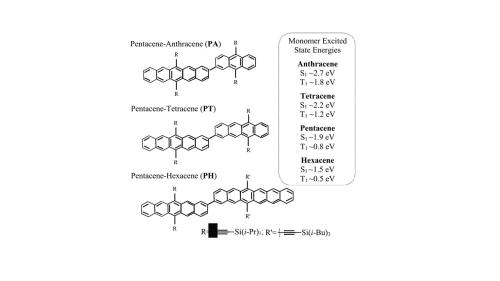Technologies Available for License
Categories: advanced materialsenergy
2016-019: Generation of long-lived triplet states in intramolecular SF Films through Molecular Engineering
Invention: 2016-019
Patent Status: U.S. Patent Number 10,752,730 was issued on August 25, 2020
For technical and licensing related questions, email tcp@bnl.gov.
Summary

Asymmetric systems where two different oligoacene monomers are covalently linked.
Singlet fission (SF) is a multiple-exciton generation process which coverts one singlet exciton into two triplet excitons and has received considerable attention because of its potential on increasing the power conversion efficiency for photovoltaic cells. Acenes are an interesting class of molecules in the field of organic electronics due to their tunable optoelectronic properties, high charge carrier mobilities, and the observation of singlet exciton fission (SF) in tetracene and higher acenes. This joint invention between BNL and Columbia University provides molecules and polymers that undergo ultrafast, intramolecular singlet fission (iSF) in oligoacene derivatives and have an enhanced fission yield. Moreover, this invention removes the morphology requirement for singlet fission, making it much more viable for application in bulk heterojunction, dye sensitized or other types of photovoltaic cells.
Description
This invention creates two triplet excitons from a singlet exciton regardless of morphology or intermolecular interactions. Specifically, a dimer of triisopropylsilylacetylene (TIPS pentacene) was observed to undergo quantitative intramolecular singlet fission. Transient absorption spectroscopy experiments revealed the disappearance of the initially photoexcited singlet and correlated rise of a triplet state in dilute solution without any dependence on concentration or other processes occurring. This multiple exciton generation has the potential to raise current in single junction solar cells or in photodetectors. In both cases, external quantum efficiencies over 100% can be obtained which are impossible without such multiple exciton generation processes.
Benefits
The Oligoacene of this invention provide quantitative singlet fission yield which can be obtained in neat films, in a solution or in a mixture. This contrasts with existing materials that depend on intermolecular interactions which only work in crystals or aggregates and are therefore difficult to implement.
Applications and Industries
The inventive materials could be widely applicable as electronic, optical, or electro-optical component or device developing including organic light emitting diodes (OLEDs), organic light emitting transistors (OLETs), solar cells, etc.
Journal Publication & Intellectual Property
- Achieving Long-Lived Triplet States in Intramolecular SF Films through Molecular Engineering (.pdf)
- Singlet fission in a hexacene dimer: energetics dictate dynamics (.pdf)
- US 10,752,730 (.pdf)
Tags: photovoltaic device
Contacts
-

Poornima Upadhya
Manager Technology Transfer & Commercialization
Technology Commercialization
(631) 344-4711, pupadhya@bnl.gov
-

Avijit Sen
IP Licensing & Commercialization
Technology Commercialization
(631) 344-3752, asen@bnl.gov




